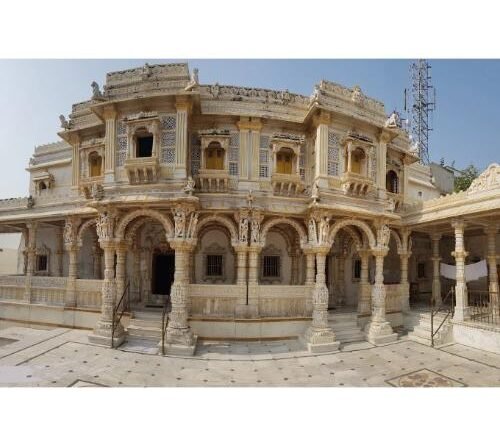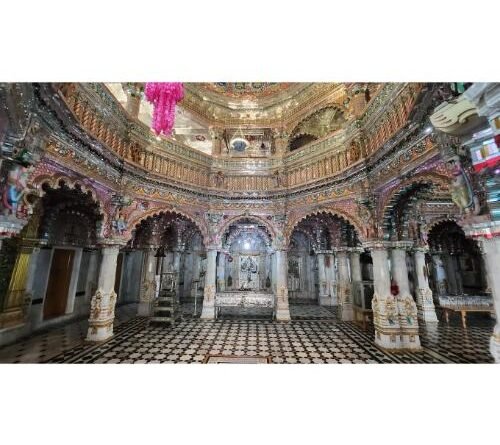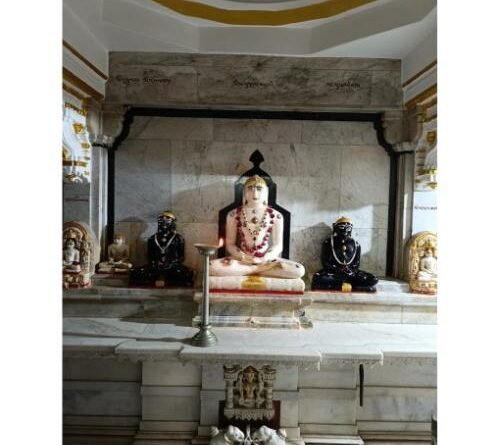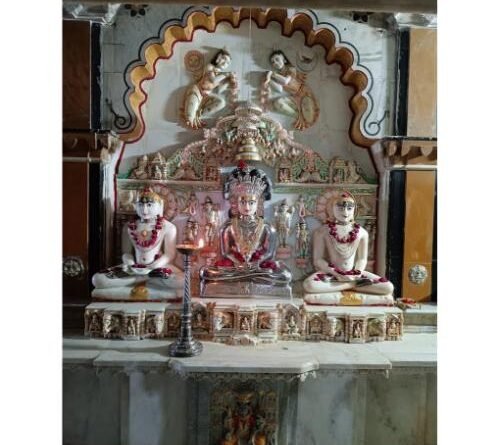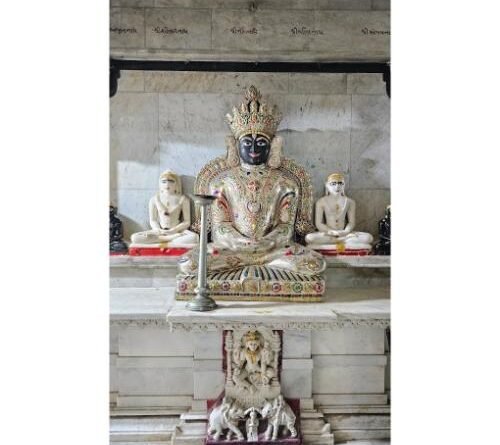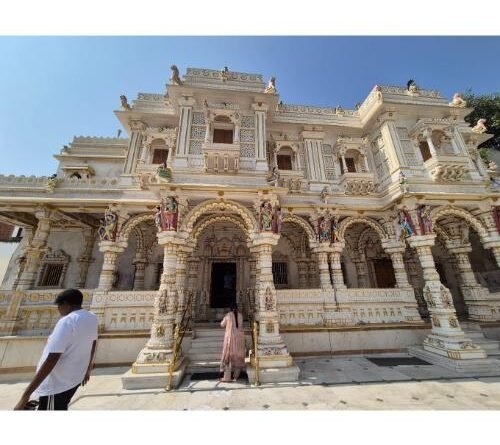108 Manoranjan Parshvnath Jain Tirth, Station Road, Pilaji Ganj,Mahesana,Gujarat
One of the oldest Jain Derasar in this part of Gujarat. The intricate mirror work on the walls and ceilings are the unique and surreal experience. Very old but still very beautiful temple. So many pratimajis.
History
This is an ancient city dating back to V.S. 12 – 13th century and established by Mehsaji Chavda. At first, there was a temple of Kalyan Parshvanath in Mehsana. Due to Muslin invasion in 14 – 15th century, this idol of Parshvanath was saved from destruction and at present it is installed in a temple in Visnagar. There is a story behind the name “Manoranjan Parshvanath”. King Mehsaji did not have any children and wanted a heir. A Jain Acharya asked him to pray to Lord Parshvanath. Mehsaji, with deep faith, prayed in front of the idol of Lord Parshvanath. His prayers were fulfilled and a son was born. In great joy and happiness he named the idol “Manoranjan Parshvanath”. This idol of Manoranjan Parshvanath is of the period of King Samprati. Previously, there were two temples in Mehsana, one of Manoranjan Parshvanath and the other of Sumathinath Bhagwan. A new two storeyed temple was built and both these idols were installed in this temple in V.S. 1920. Mehsana is a very famous pilgrim centre of Jains. The one and only temple of Shri Simandar Swami (Viharman Thirthankara of Mahavideh Kshetra) is situated on the Ahmedabad – Delhi National Highway. The height of the huge idol of Simandar Swami is 3.68 meters and it was installed by Acharya Shri Kailashsagarsuriji in V.S. 2028.
Other Temples
There are 15 other temples here. Works of art and sculpture This is a big two – storeyed temple. It is very artistic and beautifully sculpted.
Scripture:
A mention of this temple has been made in “Tirthmala”, in “Shri Sankheswar Parshvanath Chand”, in “Parshvanath Chaityaparipati”, in “Shri 108 Naamgarbhit Parshvanath Stavan” etc. “Kamal Vijay Raas” was written by Shri Hemvijaygani here in V.S.1661. An idol of Manoranjan Parshvanath is there in Kareda Parshvanath Tirth.
Other
This idol of Shree Manoranjan Parshwanath which belongs to the times of King Samprati, is installed in the majestic temple in Mahesana city. The white marble idol of Shree Manoranjan Parshwanath is 27 inches high and 22.25 inches wide. This idol does not have any snake hoods on its head. External snake hoods are added in the beautiful parikar.
Mahesana city was established by Mahesaji Chawda in the 12th and 13th century of Vikram Samvat. In this temple of Shree Manoranjan Parshwanath, there is an inscription dated Vikram Samvat 1257 on the ancient idol of a human. This inscription is considered to be of the Sheth who must have built this temple. With this, we can ascertain that the Mahesana city must be belonging to the 13th century of the Vikram Samvat. There is a reference of a 5-metal alloy idol in the Shree Shantinath Bhagwan temple of Jamnagar, which was made and installed by Sheth Rayshi Vardhaman of Mahesana. This reference also proves the early establishment of Mahesana city.
Earlier, there was a temple of Shree Kalyan Parshwanath in Mahesana city. This temple was destroyed in the attack by the Muslim kings, sometime between 14th and 15th century of Vikram Samvat. The idol was however protected and secured from this attack, and this idol is installed in the Visnagar temple. The heirs of Mahesaji ruled Mahesna city till the 14th century. Eventually, the Chawda’s kingdom of Mahesana was divided between the heirs and became smaller.
Currently all the Jain and Hindu temples present in the city are built during and after the establishment of Gaikwad rule. On Ashadh Vad 12th day of Vikram Samvat 1661, KamalVijayji took his last breath in Mahesana. In the same year, his disciple HemVijay Gani composed “Kamal Vijay Raas” in Mahesana.
There is a folk tale about the name of Manoranjan of this idol of Parshwanath Bhagwan. The rule of Mahesaji was wealthy and pomp. However, he had no heir to carry on his legacy and he remained sad about it. Some Jain monk came to Mahesana. Some Jain person who knew about the greatness of this monk ensured that Mahesaji met him. With his immense hope he disclosed his wish to have a son to carry on his heir.
This farsighted Acharya Bhagwant who saw the spiritual benefit in this wish, explained the characteristics of Shree Parshwanath Prabhu who ensures the fulfilment of all wishes of this birth as well as future births. Mahesaji sat down on a clean land and started worshipping Shree Parshwanath Prabhu in front of his idol. Because of this activity, his sadness went away. His immense wish of getting a son was completed and his mind was very pleased. In this happiness, he named this idol as Manoranjan Parshwanath.
This idol of Shree Manoranjan Parshwanathji is installed in the temple with a high summit. Earlier, there were two separate temples of Shree Manoranjan Parshwanath and Shree Sumatinathji. These temples were gathered and converted into a big temple.
In this new temple, Shree Manoranjan Parshwanathji was installed on Maha Sud 10th day of Vikram Samvat 1920, a Wednesday.
At present, Mahesana Tirth is very famous. In Vikram Samvat 2028, a new temple of Shree Simandhar Swami was constructed which increased the glory of this city. The giant idol of Shree Simandhar Swami is really worth seeing once. This tirth was established by Swargiya Pujya Achara Shree KailasSagarSuri Maharaj.
Jain Derashahar on Station Road. Mehsana City. Beautiful white carved structure. Gladden patchwork on the inside walls.










